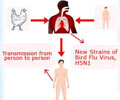The study reports documented cases of A (H3N8) avian influenza viruses crossing species boundaries and affecting a range of mammals, including dogs and horses.

Airborne transmission of human-isolated avian H3N8 influenza virus between ferrets
Go to source). Researchers in China and Nottingham, the UK, also said that the findings raise concerns of a potential epidemic or pandemic in the making and that concerted research is necessary to closely monitor such viruses in poultry and humans. The results report on the characterization of a human isolate -- from a human patient -- of the H3N8 avian influenza virus (AIV).
Human Impact of Avian H3N8 Virus
In humans, the avian H3N8 virus infection has been found to cause acute respiratory distress syndrome and can even be fatal. The virus is widespread in chicken flocks; however previously, the features of how it might be transmitted from animals to humans is poorly understood. “We demonstrate that an avian H3N8 virus isolated from a patient with severe pneumonia replicated efficiently in human bronchial and lung epithelial cells, was extremely harmful in its effects in laboratory mammalian hosts and could be passed on through respiratory droplets,” said Professor Kin-Chow Chang from at the University of Nottingham. Chang said that his team discovered that the virus had acquired human receptor binding preference and amino acid substitution PB2-E627K, which are necessary for airborne transmission.‘Using mice and ferrets as human infection models, the study found that H3N8 avian flu has adapted, causing severe animal infections and airborne transmission. #avianflu #birdflu’





“Human populations, even when vaccinated against human H3N2 virus, appear immunologically naïve to emerging mammalian-adapted H3N8 AIVs and could be vulnerable to infection at epidemic or pandemic proportions,” Chang said. "Acid resistance of influenza virus is also an important barrier for avian influenza virus to overcome to acquire the adaptability and transmissibility in new mammals or humans. The current novel H3N8 virus has not acquired the acid resistance yet. So, we should pay attention to the change in acid resistance of the novel H3N8 virus,” added Professor Jinhua Liu at the China Agricultural University in Beijing.
Global Prevalence of H3N8 Viruses in Animals
H3N8 viruses are commonly detected globally in animals. The viruses are some of the most commonly found subtypes in birds, causing little to no sign of disease in either domestic poultry or wild birds.The global health body states that zoonotic influenza type A infections may cause diseases ranging from mild upper respiratory infection (fever and cough) to rapid progression to severe pneumonia, acute respiratory distress syndrome, shock, and even death. Due to the constantly evolving nature of influenza viruses, the WHO has stressed the importance of global surveillance to detect virological, epidemiological and clinical changes associated with circulating influenza viruses which may affect human (or animal) health.
Reference:
- Airborne transmission of human-isolated avian H3N8 influenza virus between ferrets - (https://www.cell.com/cell/fulltext/S0092-8674(23)00891-7)
Source-IANS









